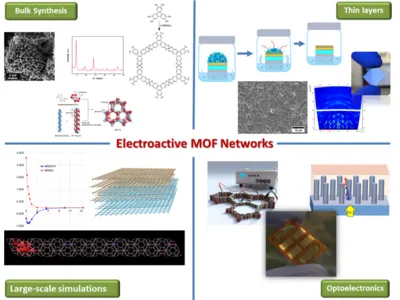Electroactive MOF networks
Electroactive MOF • M-CAT-1 • MOF-74
Thomas Bein,(a) Timothy Clark, (b) Dana Medina (a)
(a) Ludwig-Maximilians-Universität München, Department Chemie, Butenandtstr. 5-13, 81377 München.
(b) Friedrich-Alexander-Universität Erlangen-Nürnberg, Computer-Chemie-Centrum, Department Chemie und Pharmazie, Nägelsbachstr. 25, 91052 Erlangen.
We aim to develop model systems with periodic, interpenetrating networks of electron donor- and acceptor-phases based on the structural paradigm of metal-organic frameworks (MOFs). Crystalline and porous MOFs, with appreciable charge-carrier mobility, hold promise as a new platform for designing semiconductors. Through the concepts of reticular chemistry, two- and three-dimensional MOFs with encoded properties, significant electrical conductivity and intriguing optoelectronic properties are within reach. The MOFs allow for maximum control over the nature of the molecular building blocks, as well as their relative spatial orientation, their wall-thickness, and their overall orientation relative to a substrate. The goal of this project is to use a combination of theory and experiment to create such highly defined model systems to enhance our understanding of the relationship between the electronic and structural parameters and the resulting light-induced charge-carrier dynamics, and ultimately to contribute to the understanding and further improvement of solar cells.
Herein, we discuss our recent progress regarding the electrically conducting two-dimensional (2D) M-CAT-1 MOF series and MOF-74 topologies in the form of bulk and thin film systems. First, we introduced vapour-assisted conversion film synthesis for the M-CAT-1 family. For oriented Ni-CAT-1 films, photo-induced charge-carrier generation and extraction are presented, thus establishing M-CAT-1 as photo-active materials. In addition, we show that control over the morphology of 2D M-CAT-1 films enables new surface and wetting phenomena, greatly expanding the scope of applications of these materials. Next, we introduce new members of both the M-CAT family and the MOF-74 topology by employing different metal-ions and anthracene-based organic ligands, respectively. Their structural characterization and charge carrier transport properties as bulk pressed pellets are described. Enhanced electrical conductivity was recorded for Zn-ANMOF-74, with several orders of magnitude higher electrical conductivity measured compared to Zn-MOF-74. To shed light on charge transport in these systems, possible charge carrier pathways and hole stability in MOF-74 networks were simulated using the EMPIRE software.
Interested in finding out more? Click here to learn more about this overarching COORNETs team and project.
